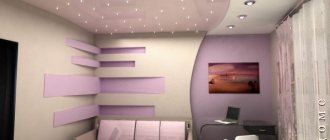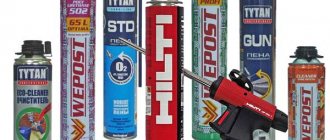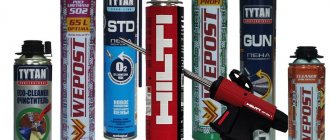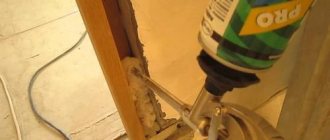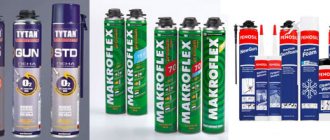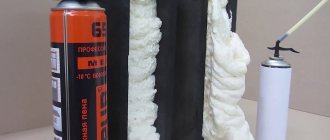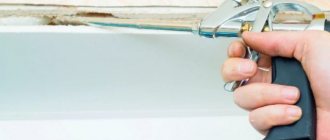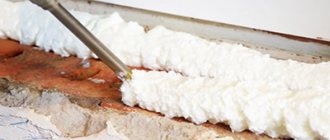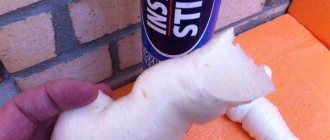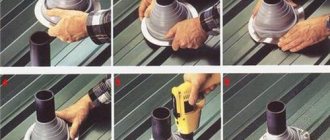Properly selected and correctly applied polyurethane foam for windows is an important component of their high-quality installation. It is difficult to imagine installing modern PVC window structures without this easy-to-use and reliable material. A novice master will have to understand the differences and features of foam in order to choose a composition from the wide range offered by stores.
Properties and scope of material
Polyurethane foam is a liquid polyurethane solution pumped into a container under pressure. When exposed to air, it quickly hardens and at the same time increases significantly in volume.
There are 2 types of foam expansion:
- Primary (when the composition leaves the cylinder). Provides ease of use: the solution can effortlessly fill any shaped recesses.
- Secondary. Among the disadvantages: an increase in the volume of sealant during final polymerization can deform the window elements. Therefore, it must be taken into account when carrying out work.
Completely hardened material acquires unique useful qualities:
- Low thermal conductivity is achieved due to air bubbles located in the thickness of the frozen material. If not for the price, foam could well be considered as an alternative to conventional insulation materials.
- The presence of air voids increases the sound insulation of the entire window structure: vibrations transmitted to the window are damped by foam. Thus, it complements the installed rubber seals, enhancing soundproofing.
- Cured foam does not transmit electric current, has water-repellent properties, and is not susceptible to rotting or mold.
- High adhesion rates make it possible to use foam as a fixing material: it securely fixes window or door frames, as well as other elements, in place.
- Depending on the brand, the composition does not support combustion or is completely resistant to fire.
Thanks to its special properties, the foam is ideal for exterior and interior use. But, like any material, it has disadvantages:
- After hardening, the excess composition is cut off. And if the cut surface is not treated appropriately, then water will get into the open pores. Over time, this causes the material to deteriorate.
- The frozen composition does not withstand exposure to ultraviolet radiation, so it must be protected from direct sunlight.
- You have to follow the rules for storing cylinders: strictly in a vertical position at a temperature range from +5 ˚С to +25 ˚С.
The high adhesion of the foam allows it to reliably adhere to surfaces made of different materials. Therefore, you should work with the composition very carefully: if it gets on your hands or other parts of the body, you can only wipe it off with the top layer of skin, which will take at least several days. When pouring, be sure to use gloves. You should also securely cover all surfaces on which the solution may drip.
If foam does get on the floor, furniture or other surfaces, it can be removed in several ways, which are described here.
USEFUL INFORMATION: Calculation of the number of heating radiators by area and volume of the room
Stages of work when foaming a window
Moisturizing the surface of walls and openings
Air humidity is of great importance in the foam polymerization process. This affects the correct reaction between its components, improves adhesion, and eliminates foam subsidence. In addition, moisturizing promotes the formation of a finely porous foam base without voids.
Before foaming, the walls of the opening must be moistened with a simple water spray. The spray reaches the required area, leaving dry the slope areas to which the vapor barrier tape will be glued. The main thing is not to overdo it with hydration. The thin walls of fine-pored foam are not able to withstand the pressure of the expelling gas. It quickly evaporates, the foam settles, and eventually voids appear.
It should be borne in mind that due to low absolute humidity, it is much more important to moisten the slope in the cold season than in the warm season.
External seam waterproofing
Despite the fact that foam is an excellent thermal insulator, it allows moisture to pass through and is destroyed in direct sunlight. Thus, it needs additional protection - external waterproofing and internal vapor barrier of window seams. This will allow the windows to be sealed with foam for the winter.
For external waterproofing, use pre-compressed sealing tape (PSUL) or vapor-permeable waterproofing tape.
PSUL is glued to the front side of the frame without tension or overlap, tightly butted on the sides and at the top until the frame is installed in the opening. The glued plastic window is carefully inserted into the opening so that the tape does not move. It is important to ensure that the PSUL fully expands before foaming the seam with polyurethane foam.
Vapor-permeable waterproofing tape is glued under low tide. It is cut to the length of the window with a margin for installation under external slopes. If the width is not enough to cover the installation seam, a tape of the same length is cut and glued to the first piece with an overlap of 20-30 mm.
Internal vapor barrier of seams
The surface of the frame and slopes must be cleaned of construction saws. The crumbling surface should be treated with a primer.
Vapor barrier tape is made of aluminum foil and butyl rubber with one or two layers of adhesive applied, covered with paper strips. This gives it elasticity. One side of the tape may have a non-woven backing for better adhesion to the plaster. The variety of tape widths makes it possible to provide reliable vapor barrier for seams of any size.
The tape is glued tightly with a narrow adhesive layer along the entire length of the window frame, without tears or peeling. The second edge of the vapor barrier tape remains unattached.
Foaming seams
To properly foam a window, the foam balloon is heated to the temperature indicated in the instructions, shaken vigorously up and down 20 times. You also need to shake it frequently during operation.
Professional or household?
Based on the design features of the cylinders and other indicators, household and professional foam are distinguished.
The compounds that the masters work with are used only with a special gun. To secure it in the cylinder, a special valve is provided.
The use of this design provides the following advantages:
- The ergonomics of the gun allows the master to fill cracks with one hand. The second remains free, due to which you can work alone at certain stages.
- The gun makes it possible to accurately dose the volume of solution released. This reduces consumption by reducing unnecessary waste.
- A thin, long nozzle will easily deliver the solution into hard-to-reach cracks and holes.
- The cylinder can be used in any position.
- The reusable valve ensures the safety of the solution between repairs.
When choosing professional cylinders, you do not need to solve the frequently asked question: where can the remaining solution be usefully used?
- Professional compositions have better performance characteristics than household ones. For example, they have a lower secondary expansion coefficient, which makes their use more convenient.
Techniques for pouring foam using a professional gun are shown in the following video.
Mr. Build strongly recommends: to install plastic windows, use only professional foam. Secondary expansion will not create unnecessary load on the structure or displace frame elements. The density of the professional compositions is maximum, and this will ensure the best quality of fastening, insulation and sealing of the seam.
Choose a gun based on budget, ergonomics and service life. For a single procedure, the cheapest one with plastic parts will do, but for professional use, give preference to dismountable high-quality models.
Household foam has less outstanding performance characteristics: worse adhesion, a higher coefficient of secondary expansion, and less material yield from the cylinder. It is sold in containers equipped with a plastic tube for supplying the solution. It is screwed onto the valve before blowing begins. It is recommended to use the entire bottle at once.
Working with household foam is less convenient: both hands are used, and the can must be placed bottom up. This will ensure a more complete release of the solution. Use it with extreme caution, in the least important places. Fill the seam to no more than 50% depth!
Compound
Most of the consumables used contain substances to impart elasticity (plasticizers) and surfactants. To activate the polymerization process, a reaction of 2 components is needed.
- Prepolymer diisocyanate. The substance is in a liquid aggregate state. When sprayed, it absorbs moisture from the air, forming a polyurethane mass.
- The propellant responsible for the aerosol properties is propane. The gas is inside the cylinder and is involved in the atomization of the diisocyanate.
After spraying the balloon in the open air, polymerization occurs. Under the influence of air and a humid environment, the mass hardens. A porous material is formed that fills all the cracks.
Soundproofing foam
If the windows themselves do not transmit noise, then the polyurethane foam on which they are mounted is an excellent conductor of noise, since it is light, hard, and has a closed cellular structure, which facilitates the unhindered passage of sound waves.
USEFUL INFORMATION: How to choose the right blinds for plastic windows: by room and size (40 photos)
Therefore, when installing windows or doors, it is necessary to use special soundproofing foam, which, unlike conventional polyurethane foam, has properties important for sound insulation:
- high density to reflect sound waves;
- elasticity to reduce vibration transmission;
- high-quality filling of cavities and cracks to prevent sound from “leaking” into the room.
MAXFORTE SaundFLEX foam has these characteristics
Compared to conventional construction foams, the use of MAXFORTE SoundFLEX foam adds more than 10 dB to sound insulation, which is equivalent to a noise reduction of 2-3 times.
The difference between regular mounting foam and soundproofing foam can be seen in the video:
If you squeeze a piece of polyurethane foam in your hand, it will simply collapse, unlike specialized soundproofing foam. Like a sponge, it will return to its shape. It does not harden and thus does not become a sound bridge.
Specifications
As mentioned above, various types of work are performed with the help of polyurethane, this not only applies to the installation of windows and doors, this building material is used to seal dimensional cracks, fill voids and fix structures. If you familiarize yourself in detail with all its positive properties, you can conclude that it can be compared with other sealing substances due to its ability to qualitatively seal the desired surfaces.
Before considering the issue of drying time for polyurethane foam, it is recommended that you familiarize yourself with the characteristics of the indispensable construction sealant, its properties and features.
Output volume
This indicator demonstrates how the material has changed compared to its original state. This volume is measured in liters. The main aspects influencing this indicator are the air temperature and humidity of the structure being finished.
Surface adhesion
This parameter helps determine the quality of adhesion of the material to the coating. The exception applies only to surfaces such as grease coatings, polyethylene, silicone, Teflon, etc.
Viscosity coefficient
This indicator will depend largely on the quality and quantity of components used to make the material. This characteristic is also influenced by external factors - temperature. It is recommended to work with the substance according to the instructions, which indicate the exact data and permissible air temperatures.
If you use the sealant outside the specified limits, it will lose its basic properties, and the initial product will not meet all the requirements.
Winter or summer?
Foam is divided according to the seasonality of its use. It happens:
- Summer, suitable for work at temperatures above +5 ˚С.
- Winter, allowing you to seal cracks at temperatures down to -18˚ C.
- All-season. Seen and used less frequently. Professionals advise using it during transition periods in autumn and winter or getting by with the first two varieties.
How to use the product?
Before starting work, any surface must be prepared. Dirt needs to be removed; since the foam interacts with moisture, it is advisable to moisten the surfaces with water, but this can only be done at positive temperatures. In other cases, this action is undesirable. If work takes place outside, at sub-zero temperatures, it is necessary to remove ice and snow from the surface.
In order for the foam to readily leave the container and gain sufficient density, it should be kept in a warm room for about a day before starting work. It is prohibited to artificially heat the cylinder using an open flame. It may explode because it is under pressure.
Foam output in different cylinders
Polyurethane foam is the best idea for attaching a door frame, but when using it, you need to firmly fix the frame with supports and leave enough space for the foam to expand, otherwise you may end up with a deformed structure. You need to use the cylinder while holding it upside down. The foam must be shaken well before use.
The decision which polyurethane foam to choose for window installation remains with the buyer; the main criterion is a careful study of the packaging. Cylinders that are too light should be avoided.
Flammability of foam
The compositions also differ in flammability parameters:
- B1 – the highest fire safety class, does not ignite even upon contact with open fire.
- B2 – does not burn on its own, without an additional heating source. Such compositions are called self-extinguishing.
- B3 – lowest flammability class. This material is not recommended for use, especially in residential areas.
Varieties
Polyurethane foam for PVC windows is divided into types: according to application temperature, composition, cylinder design, and flammability class. In order to answer the question of which foam is best for foaming plastic windows, you need to understand the above properties:
- According to application temperature. Cylinders are marked for summer, winter and all-season types. This concept indicates the maximum permissible ambient temperature at which work can be carried out. The temperature range of the summer version ranges from +5 to +40. For work in winter - up to -20. All-season has the widest temperature range - from -10 to +40. This difference is explained by the low moisture content in the air in winter. After hardening, any type of foam can withstand temperature changes from -50 to +90.
- According to the design of the cylinder. There are only two types of design - professional and household. A professional cylinder cannot be used without a special mounting gun. The gun allows you to accurately dispense the substance in the right quantity. Makes it possible to reach the most inaccessible places. Mobile in use. Can be used with one hand. The special device of the gun allows you to continue using the polyurethane foam remaining in the cylinder. The household cylinder is equipped with a special plastic adapter. After screwing the supplied special tube onto the nozzle, the cylinder is ready for use. Household foam has weaker adhesion and a higher degree of secondary expansion. The design of the household cylinder provides for one-time use. But if you are planning a small amount of work, for example, self-installation of plastic windows, then household polyurethane foam is your option.
- By flammability class. There are three types of flammability: combustible, fire-resistant and self-extinguishing. The fireproof option does not ignite upon contact with fire. Combustible fuel is not recommended for residential use.
- According to its composition, it is divided into two types: simple one-component and improved two-component. As already mentioned, additives are added to the composition to improve performance. Two-component foam is significantly superior to the simple version in terms of basic characteristics.
Rules for choosing foam for installing PVC windows
For high-quality installation of window blocks, the composition most suitable for a particular case is selected. What to look for when choosing?
- The temperature at which the cracks will be sealed. It is used to choose winter, summer or all-season foam.
- On the secondary expansion coefficient. The lower the value, the better. It is recommended not to use formulations with an indicator of more than 15–20%. Professional foam easily fits into such a framework, but with household foam the choice should be made carefully.
- For expiration date. No one can predict how the behavior of the solution will change after storage time. It's better not to take risks.
- To the fullness of the cylinder. Underfilling is a common occurrence. It’s easy to check: to do this, weigh the canister. A full container of 750 ml weighs about 900 g.
USEFUL INFORMATION: Advantages of a touch-sensitive water tap: choosing an electronic mixer
Calculating the required number of cylinders causes many problems. It is believed that per linear meter when installing windows in a panel high-rise, 300 ml of foam will be required, for brick the volume of material is 400–450 ml, for houses built in Stalin - 500 ml. But on the bottle the manufacturer indicates the yield of the sealant under ideal conditions; this cannot be achieved in reality. Therefore, an extra cylinder in reserve will not hurt.
Average prices in the Russian Federation
Among the most popular options for polyurethane foam are the following :
- Instant installation – from 250 to 300 rubles.
- Makroflex - from 325 rubles.
- Soudal - from 295 rubles.
- Penosil - from 285 to 315 rubles.
- Titan - from 345 rubles.
Note. It must be taken into account that the cost is determined not only by regional characteristics, but also by markups of individual stores.
Rating of polyurethane foam brands
Professionals prefer proven brands. The following mounting compositions have proven themselves on the Russian market:
- "Moment-Montazh" - foam from a domestic manufacturer. Most often all-season, presented in professional and household containers. Dense, homogeneous with good adhesion, it can be painted. The material is characterized by secondary expansion, so you need to work with it carefully, fixing the window elements with spacers.
- Soudal - compositions with a fine-porous structure without an unpleasant odor. Three modifications - summer, winter, fire-resistant. Shrinkage and secondary swelling are minimal, the material is characterized by high adhesion and uniform hardening. For delicate installation work, a composition with minimal re-expansion is suitable: SOUDAFOAM GUN LOW EXPANSION.
- Makroflex is a sealant with good adhesion and a uniform structure. With primary expansion it increases 2 times, secondary expansion is insignificant. It can be summer or earthy. It is allowed to trim the excess after 3-4 hours.
- Penosil is a non-shrinking composition with low secondary expansion and a dense structure, odorless. Gives a record high yield.
- Tytan. It does not emit toxic fumes during operation and has a weak, non-caustic odor. The expansion of the second type is practically absent. Available in household and professional, winter and fire-resistant versions. Hardens quickly, excess can be cut off within an hour.
What is a non-expanding option?
Non-expanding foam is a kind of sealant, the expansion of which after hardening occurs no more than one and a half times. It is great for working with delicate materials.
There are several types of low expansion foam:
- Silicone - characterized by excellent interaction with most surfaces. Adhere well to smooth materials. The sealed seam, obtained with silicone mass, protects from atmospheric influences and is slightly deformed.
- Polyurethane - standard mounting foams.
- Acrylic - do not contain solvents; this mixture is good for filling small joints. However, acrylic-based compositions are less resistant to aggressive external factors.
For most work related to filling small openings, silicone mass is used. Such sealants are universal, have good elasticity, strength and durability. They do not expand and harden when exposed to a humid environment.
Key Features
Reliability of polyurethane foam parameters can be achieved by following the technological process when installing a plastic window and by choosing the right material. The characteristics of the foam must correspond to the conditions in which it is intended to be used: humidity, temperature, time of year and subsequent finishing of window slopes .
Installation of plastic windows is not complete without the use of polyurethane foam.
This modern material recently appeared on the construction market and gained its popularity along with metal-plastic structures, since the technology for their installation cannot be done without polyurethane foam. The mixture has high adhesive properties, does not allow electric current to pass through, easily fills hard-to-reach voids, is not subject to rotting and has heat and sound insulation qualities.

